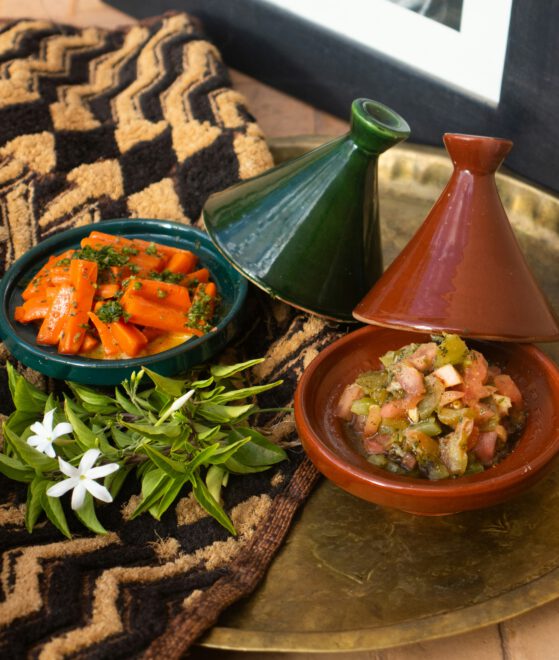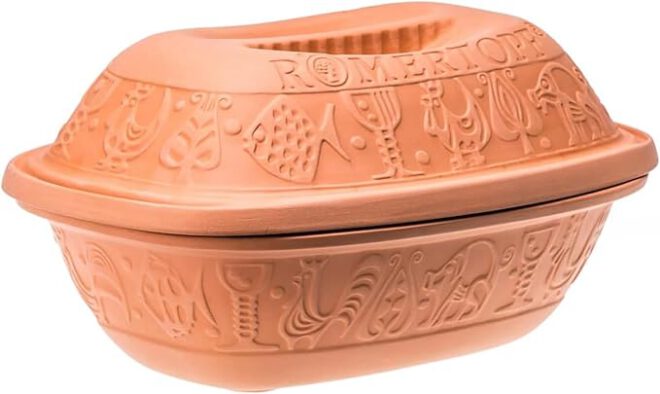Does this look like a pot you’d cook in? Soup, possibly? This 6000 year old clay pot was recently retrieved from a bog in Denmark. A neolithic householder had cooked seafood in it, according to the analysis made of food residues scraped off from the inside. Cooking in clay has been around for a long, long time.
Porous clay retains and releases flavors. I imagine everything cooked in that pot 6000 years ago tasted like fish. I’d advise modern cooks to save one or two clay pots only for seafood. And keep your dessert ramekins for dessert only – you don’t want your creme brulee to taste like garlic custard.

How about this ancient Greek setup? With the exceptions of the skillet and the grill, the whole stove and the pots are made of clay. Clay keeps a steady, slow heat going as long as the fuel lasts. The ancient Greek obviously expected to cook soup, stew, or pottage in the three pots poised on those funnel-like chimneys. I’ll bet the whole thing got hot enough to burn the hand. Since cooking in clay is a low and slow process, they must have started cooking early in the morning to be on time for lunch.
Related: can clay jugs filter water?
Dug out from the earth itself, clay needs patient processing to yield clean, malleable material. Most clay pots need a one-time preliminary seasoning in order to cook out the taste of raw clay. And they’re fragile. They must be protected from thermal shock to prevent cracks. Drying one isn’t a matter of wiping it out with a dish cloth; it has to be air-dried to prevent mold. And unless you’re lucky enough to live near a potter, you can expect to pay nicely for a beautifully-turned out tajine or Romertopf pot.

Unless you fly out to Morocco, where you can pick up a traditional tajine like this one in the souk:

So why bother to cook in clay when you can pick up all the metal cookware you need in your neighborhood supermarket?
First, flavor. Anything cooked in clay tastes better. If you appreciate traditional foods cooked low and slow, you’ll enjoy the deep flavors and textures that clay pots grant. Slow, even heat ensures that the ingredients’ flavors bloom and blend, and that foods requiring long cooking, like beans and tough cuts of meat, emerge from the pot tender and juicy.
The more often you cook in a clay pot, the better the food from it tastes. To put it poetically, the clay retains some of the soul of the food – the flavors of spices and fats – which it releases to the next potful. A well-used and cared-for clay pot, even a simple tagra like the one below, becomes a treasure over time. (The photo shows slow-cooked salmon and lemons.)

Then there’s the satisfaction of handling a pot made from sustainable prime material; especially if the pot is beautiful.
Clay pot styles vary a lot. Tajines, for example, require very little or no liquid for stews or braised dishes. Cooking vapors condense inside their conical tops and drop back down on the food, resulting in foods with undiluted flavor.
Romertopf pots are another specific type, with their glaze and two parts. Being soaked before cooking starts, the closed Romertopf releases steam around the food inside, producing deliciously roasted, juicy chicken and meat. (To create a golden, crisp crust, you remove the top and cook the dish a further 20 minutes.)

Cooking in clay takes longer, because you start with low heat and gradually increase it. But clay retains heat for a long time, which guarantees that the food stays hot for a long time after you take the pot off the stove or out of the oven.
There are clay pots for every use. Stews, soups, and beans are the first foods that come to mind, but there are traditional clay vessels for casseroles, frittatas, baked potatoes, bread forms and even custard cups. I love the pot that Green Prophet’s founder Karin Kloosterman made in her own kiln.

It could make slow-cooked stew or soup, but I prefer to use it as a bread cloche. Here’s the bread:

If you live within reach of a potter, or travel to places where clay pots are made locally, buy them there. Where I live, there’s a warehouse that imports housewares from Morocco. I’ve bought tajines and tagras there. A heavy guvec stew pot on my shelf came from Turkey. I’ve also found clay cookware in a trendy shop in the local mall. Otherwise, you can order clay pots online via Amazon, Etsy, and similar sites.
You don’t need a exotic spices and herbs ordered online to make good use of clay pots. Below is a chicken tajine I cooked recently. Just chicken, veg, and the ground spices I keep around: cumin, turmeric and paprika. I could have substituted thyme, bay leaf, and a splash of white wine just as easily.

Regarding safety and fear of lead in glazed pots: all cooking pottery sold in the U.S. is regulated by the U.S. Food and Drug Administration. If you like to use a slow cooker on these cold winter days, remember that all the inserts of slow cookers are made of glazed clay, so you’ve been cooking perfectly safely with what’s basically a clay pot.
Unglazed pots are fine.
Don’t cook in antique pots you pick up in yard sales. Keep them for display. If you’re determined to cook in an old pot – unless it’s your Grandma’s familiar, treasured and well-used one – buy a lead test in your local hardware store and apply it to the pot.
For an authoritative book on cooking in clay, I recommend Paula Wolfert’s classic, Mediterranean Clay Pot Cooking. In it the most common types of clay pots are detailed, with valuable tips on handling clay pots, cooking different types of foods, and incidental recipes like preserved lemons and tomato paste. The book includes lists of food sources and clay pot sources. The bibliography is worth going through. The recipes largely reflect the foods of Morocco, Turkey, France, and Italy.
Follow Green Prophet for delicious recipes cooked in clay (or other) pots:






